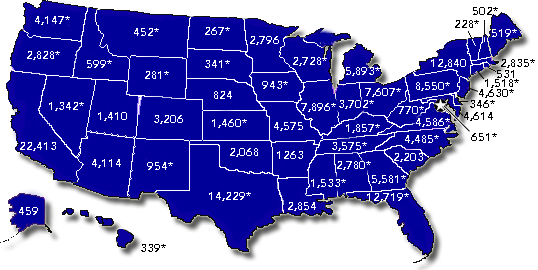Incidence & Distribution
TBIs contribute to a substantial number of deaths and cases of permanent
disability annually.
Each year in the United States, an estimated
-
1.4 million people sustain a TBI. Of those, 230,000 are hospitalized and
survive, which is more than 20 times the number of hospitalizations for spinal
cord injury, another key disabling injury. (CDC 2001; Langlois et al. 2004).
-
50,000 people die from a TBI, (Langlois et al.2004).
-
80,000 to 90,000 people experience the onset of long-term or lifelong
disability associated with a TBI (Thurman et al. 1999).
Among children ages 0 to 14 years, TBI results in an estimated
-
3,000 deaths,
-
29,000 hospitalizations, and
-
400,000 emergency department visits (Langlois et al. 2001).
Approximately 75% of TBI that occurs each year, are concussions or other forms
of mild TBI. (CDC 2003).
An estimated 300,000 sports-related brain injuries of mild to moderate
severity occur in the United States each year (Sosin et al. 1996).
Number of nonfatal traumatic brain injury (TBI) hospitalization cases in
1998, on map and listed by state.

* Estimated number of cases
|
State
|
Cases
|
State
|
Cases
|
|
AK
|
459
|
MT
|
*452
|
|
AL
|
*2,780
|
NC
|
*4,485
|
|
AR
|
1,263
|
ND
|
*267
|
|
AZ
|
4,114
|
NE
|
824
|
|
CA
|
22,413
|
NH
|
*502
|
|
CO
|
3,206
|
NJ
|
*4,630
|
|
CT
|
*1,518
|
NM
|
*954
|
|
DC
|
*651
|
NV
|
*1,342
|
|
DE
|
*346
|
NY
|
12,840
|
|
FL
|
*12,719
|
OH
|
*7,607
|
|
GA
|
*5,581
|
OK
|
2,068
|
|
HI
|
*339
|
OR
|
*2,828
|
|
IA
|
*943
|
PA
|
*8,550
|
|
ID
|
*599
|
RI
|
531
|
|
IL
|
*7,896
|
SC
|
2,203
|
|
IN
|
*3,702
|
SD
|
*341
|
|
KS
|
*1,460
|
TN
|
*3,575
|
|
KY
|
*1,857
|
TX
|
*14,229
|
|
LA
|
2,854
|
UT
|
1,410
|
|
MA
|
*2,835
|
VA
|
*4,586
|
|
MD
|
4,614
|
VT
|
*228
|
|
ME
|
*519
|
WA
|
*4,147
|
|
MI
|
*5,893
|
WI
|
*2,728
|
|
MN
|
2,796
|
WV
|
*770
|
|
MO
|
4,575
|
WY
|
*281
|
|
MS
|
*1,533
|
|
|
* Estimated number of cases
Data source: Kegler et al, 2003
References
Centers for Disease Control and Prevention (CDC), National Center for Injury
Prevention and Control. Report to Congress on Mild Traumatic Brain Injury in
the United States: Steps to Prevent a Serious Public Health Problem, Centers
for Disease Control and Prevention, 2003.
Centers for Disease Control and Prevention (CDC). Injury fact book 2001-2002.
Atlanta (GA): Centers for Disease Control and Prevention, 2001.
Centers for Disease Control and Prevention (CDC), Horseback-Riding-Associated
Traumatic Brain Injuries – Oklahoma, 1992-1994. MMWR 45(10); 202-211, 1996.
Centers for Disease Control and Prevention (CDC), National Center for Injury
Prevention and Control. Traumatic Brain Injury in the United States—A Report
to Congress. Atlanta (GA): Centers for Disease Control and Prevention;1999b.
Kegler S, Coronado V, Annest J, Thurman D. Estimating nonfatal traumatic brain
injury hospitilizations using an urban/rural index. Journal Head Trauma
Rehabil [serial online] 2003 Nov-Dec [cited year mth day];18(6):469-78.
Available from URL: http://www.cdc.gov/doc.do/id/0900f3ec8011bd92.
Langlois J, Gotsch K. Traumatic Brain Injury in the United States: Assessing
Outcomes in Children. Atlanta (GA): National Center for Injury Prevention and
Control, Centers for Disease Control and Prevention (CDC); 2001.
Sosin D, Sniezek J, Thurman D. Incidence of mild and moderate brain injury in
the United States, 1991. Brain Injury 1996; 10(1):47-54.
Thurman D, Alverson C, Dunn K, Guerrero J, Sniezek J. Traumatic brain injury
in the United States: a public health perspective. Journal of Head Trauma and
Rehabilitation 1999;14(6):602–15.
Langlois JA, Rutland-Brown W, Thomas KE. Traumatic Brain Injury in the United
States: Emergency Department Visits, Hospitalizations, and Deaths. Atlanta
(GA): Centers for Disease Control and Prevention, National Center for Injury
Prevention and Control; 2004
Date last reviewed: 10/11/2004
|
